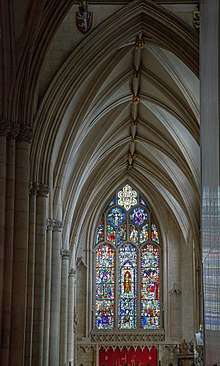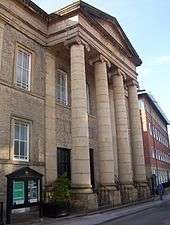Religion in York
Religion in York can be traced back to the City's foundation in Roman times with evidence of York's first Christian community dating from this period.

In 1086, the Domesday Book listed eight churches and a Minster (not the current building). The number had declined to 39 by 1428 due to taxation; 19 medieval churches are in use today. [1]
History
Roman
Polytheism
A range of evidence about Roman religious beliefs of the people of Eboracum have been found including altars to Mars, Hercules, Jupiter and Fortune, while phallic amulets are the most commonly found type of good luck charm. In terms of number of reference the most popular deities were the spiritual representation (genius) of Eboracum and the Mother Goddess, there is also evidence of local or regional deities. Evidence showing the worship of eastern deities has also been found during excavations in York. For example, evidence of the Mithras cult, which was popular among the military, has been found including a sculpture showing Mithras slaying a bull and a dedication to Arimanius, the god of evil in the Mithraic tradition.[2] Another example is the dedication of a temple to Serapis a Hellenistic-Egyptian God by the Commander of the Sixth Legion.[3]
Christianity
There was also a Christian community in Eboracum although it is unknown when this was first formed and in archeological terms there is virtually no record of it. The first evidence of this community is a document noting the attendance of Bishop Eborius of Eboracum at the Council of Arles in 314.[2] The Episcopal see at Eboracum was called Eboracensis in Latin and Bishops from the See also attended the First Council of Nicaea in 325, the Council of Sardica, and the Council of Ariminum.[4]
On 16 March 1190, a mob of townsfolk forced the Jews in York to flee into Clifford's Tower, which was under the control of the sheriff. The castle was set on fire and the Jews were massacred. It is likely that various local magnates who were debtors of the Jews helped instigate this massacre or, at least, did nothing to prevent it. It came during a time of widespread attacks against Jews in Britain. The Jewish community in York did recover after the massacre and a Jewish presence remained in York until the expulsion of Jews from England took place in 1290.[5]
In the intervening years, though, the pressure on the Jews of Yorkshire increased, especially by those who were in debt to them. A deed of 1249, for instance, between the Anglo-Norman Hamond de Levet (Levett) and several donors to Yorkshire's Roche Abbey, required the donors to put the "Hebrew letter with their seal," acknowledging that the Abbey had likely borrowed money from Jewish lenders in York.[6]
Reformation
Anglicanism
Dissolution of Christian orders
Roman Catholicism
Church of England
Located in York are the Mother Church, York Minster, and administrative centre of the Church of England's Diocese of York, as well as Bishopthorpe Palace the official residence of the Archbishop of York the second highest ranking cleric the Church. There are 32 Church of England churches within the area of the City of York[8]
Roman Catholic
York is part of the Central Vicariate of the Diocese of Middlesbrough and has eight Roman Catholic Churches and one separate shrine to St. Margaret Clitherow, where masses are held, located in The Shambles. The oldest active parish is that of St. Wilfrid which was formed in 1710. The current church at High Petergate was built in 1862-4 to a design by architect George Goldie.[9]
Religious Society of Friends
There are three meeting houses of the Religious Society of Friends in York although meetings are held at other venues including The Retreat and University of York.[10]
York has a long association with the Religious Society of Friends, known as the Quakers, and founded two schools in the city Bootham School in 1823 and The Mount in 1831. The Retreat is a large Quaker mental hospital, situated in the east of the city outside the city walls. It was founded in 1796 by William Tuke; over the next century his son Henry Tuke, grandson Samuel Tuke and great-grandson Daniel Hack Tuke also devoted themselves to mental health reform, continuing to reform The Retreat and publishing a number of works on the subject.[11] The York-born Quaker chocolate entrepreneurs and social reformers Joseph Rowntree and Benjamin Seebohm Rowntree left an indelible mark on the city, through both their business interests and their philanthropy. They built the village of New Earswick to provide quality affordable housing for their employees, contributed to the building of York Public Library and the created Rowntree Park. The four Rowntree Trusts, funded from the Rowntree legacies, are based in York.[12]
Methodists

The York Methodist Circuit is part of the York and Hull District and comprises 36 churches and communities across the city of York and the surrounding area.[13]
Elmfield College (1864–1932) was an important Primitive Methodist college, in Heworth, near York.
In 1932 the York and Whitby District was formed following the unification of the Primitive, Wesleyan and United Methodist churches. This was superseded by the York and Hull District in 1957 as part of a nationwide re-modelling of Methodist Districts.[14]
Unitarianism
A Unitarian chapel is located on St Saviorgate near the town centre. Its origins are found in the building of a chapel on that site in 1689.
Judaism
York had an extensive Jewish history in the Middle Ages, but then no Jewish community of note until the late 19th century. This community dwindled and its synagogue formally closed in 1975.[15]
In 2014, the York Liberal Jewish Community was founded by Liberal Judaism's senior rabbi Danny Rich.[16] It holds monthly services and is led by visiting student rabbis from Leo Baeck College in London.[17]
Islam
There is one Mosque in York which also contains a UK Islamic Mission Islamic centre.[18] In 2007 after armed police were put on patrol in York as a response to terrorist threats Professor Mohamed El-Gomati, of York Mosque, commented that "People are trying to change our way of life – everybody's way of life, not just a white person's or a brown person's . . . We are all in this together. I am happy to say to extremists, of which thankfully we don't have any in York, that what they are doing is wrong, is non-Islamic."[19]
Buddhism
Various Buddhist traditions are represented in and around York.
See also
- History of York
- Medieval churches of York
- Diocese of York
- Southlands Methodist Church
References
- "York and its Churches" (PDF). Visit York. 30 June 2017. Retrieved 21 June 2020.
- Hall, Richard (1996) [1996]. English Heritage: Book of York (1st ed.). B.T.Batsford Ltd. pp. 97–101. ISBN 0-7134-7720-2.
- Hartley, Elizabeth [1985]. Roman Life at the Yorkshire Museum, The Yorkshire Museum, ISBN 0-905807-02-2 P.25
- Ancient See of York, New Advent (2007), retrieved 25 October 2007
- Hall, English Heritage: Book of York, Pages 58–59
- Yorkshire: The History of Roche Abbey, from Its Founding to Its Dissolution, James Hobson Aveling, Robert White, Worksop, 1870
- "York (Local Authority)". United Kingdom Census 2001. Office for National Statistics. 2001. Retrieved 11 July 2007.
- Welcome, The Diocese of York (2007), retrieved 6 November 2007
- Parishes, Middlesbrough Diocese (2007), retrieved 5 November 2007
- Home, Quakers in the York area, retrieved 6 November 2007
- The Retreat – Our History, The Retreat (2007), retrieved 5 November 2007
- Joseph Rowntree, Spartacus Educational, retrieved 5 November 2007
- "About us". York Methodists. Retrieved 2 May 2020.
- "fonds MRD/3 - District Records of the Methodist Church, Methodist Connexion, York and Hull District". Borthwick Institute for Archives. Retrieved 2 May 2020.
- "York Jewish Community and Synagogues". JCR-UK. Retrieved 12 April 2020.
- Sherwood, Harriet. "Eight centuries after the pogrom, pride flickers again in York's Jewish community". The Guardian. Retrieved 12 April 2020.
- "Services". York Liberal Jewish Community. Retrieved 12 April 2020.
- UKIM Educational Centre Project Archived 28 June 2008 at the Wayback Machine, UK Islamic Mission Islamic (2007), retrieved 5 November 2007
- Armed police on the streets of York, York Press (2007), retrieved 5 November 2007